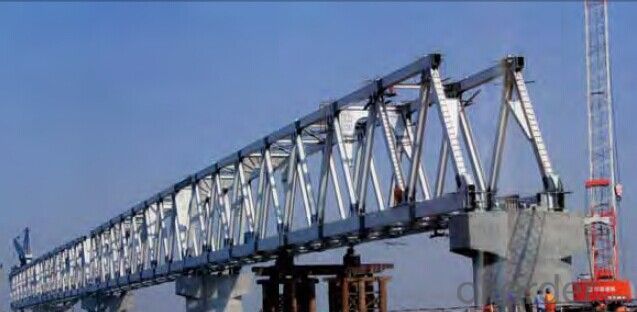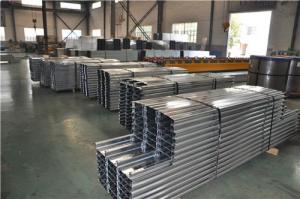Steel Structure with High Quality
- Loading Port:
- China Main Port
- Payment Terms:
- TT OR LC
- Min Order Qty:
- -
- Supply Capability:
- -
OKorder Service Pledge
OKorder Financial Service
You Might Also Like
Steel Structure
Description:
1.Length of the welding withnot indication, full welding should be applied
2.Seam without indication is fillet weld, height is 0.75t
3.The cutting angle without indication, radius R=30
4.Cutting angle not specified should be
5.The diameter of the hole for the bolt if not specified, D=22

Project Reference:
Taiyuan to Zhongwei (Yinchuan) Railway Yongning Yellow River Grand Bridge Project is a
major project controlled by Ministry of Railways, with total length of 3942.08m, and total weight
of steel structure of 5,200 tons. The main features adopt integral joint structure with required
percentage of perforation of 100%.

- Q:What is a light portal steel frame?
- The light portal frame is also called the light portal frame structure"The light portal frame structure is mainly refers to: the bearing structure for single or multi span portal frame, with light roof and light wall, can set up the weight of not more than 20t, light duty suspension crane bridge crane or 3T monolayer steel structure workshop.
- Q:How are steel structures designed to resist wind forces?
- Steel structures are designed to resist wind forces through various methods. Firstly, the shape and configuration of the structure are carefully considered to minimize wind loads. Streamlined designs, such as curved surfaces or tapered forms, help reduce wind resistance. Additionally, steel structures are designed with adequate stiffness and strength to withstand wind loads. This is achieved by using high-strength steel materials and optimizing the structural elements' sizes and connections. Engineers also consider the dynamic behavior of the structure under wind-induced vibrations and ensure that it remains stable and safe. Furthermore, steel structures may incorporate features like bracing systems, diaphragms, and dampers to enhance their ability to resist wind forces. These elements help distribute the wind loads efficiently and dissipate energy, minimizing the impact of wind on the structure. Overall, the design of steel structures for wind resistance involves a combination of aerodynamic principles, structural analysis, and appropriate measures to ensure stability, strength, and safety against wind forces.
- Q:How do steel structures withstand environmental forces such as wind and earthquakes?
- Steel structures are able to withstand environmental forces such as wind and earthquakes due to their inherent strength and flexibility. The high strength of steel allows it to resist the forces exerted by strong winds and earthquakes without buckling or collapsing. Additionally, steel's ductility allows it to absorb and dissipate energy during seismic events, preventing catastrophic failure. The combination of strength and flexibility makes steel an ideal material for constructing buildings and structures that can safely withstand these environmental forces.
- Q:What is the role of welding in steel structures?
- The significance and indispensability of welding in steel structures cannot be overstated. Welding, which involves the joining of metal pieces, is widely utilized in the construction of steel structures. Firstly, welding imparts structural integrity and strength to steel structures. Through the fusion of metal pieces, welding creates a seamless and continuous connection, bolstering the structure and enabling it to withstand external forces like wind, earthquakes, and heavy loads. This guarantees the overall stability and safety of the steel structure. Additionally, welding allows for the fabrication of intricate and complex designs in steel structures. It enables the construction of various shapes and sizes, making it feasible to create buildings, bridges, pipelines, and other structures with specific architectural and functional requirements. Welding also facilitates the joining of different steel components, such as beams, columns, and plates, enabling the creation of large and robust structures. Moreover, welding brings about cost-effectiveness and efficiency in the construction of steel structures. By employing welding techniques, it becomes possible to swiftly join different steel elements, thereby reducing the overall construction time. This leads to cost savings in terms of labor and materials. Furthermore, welding allows for the assembly and disassembly of steel structures, making them easier to transport and install on-site. Furthermore, welding ensures the longevity and durability of steel structures. By establishing strong and dependable connections, welding aids in preventing the formation of weak points or potential failure zones in the structure. This enhances the lifespan of the steel structure, reducing the need for frequent maintenance and repairs. In summary, welding plays a crucial role in steel structures by providing structural integrity, enabling complex designs, ensuring cost-effectiveness and efficiency, and enhancing longevity and durability. Without welding, the construction and functionality of steel structures would be significantly compromised.
- Q:What are the unique challenges in designing steel structures in coastal areas?
- One of the unique challenges in designing steel structures in coastal areas is the presence of saltwater and its corrosive effects on steel. The high salt content in the air and water can accelerate the corrosion process, leading to structural integrity issues over time. Therefore, proper material selection, protective coatings, and ongoing maintenance are crucial to ensure the durability and longevity of steel structures in coastal environments. Additionally, coastal areas are often prone to extreme weather events such as hurricanes and tropical storms, requiring designs that can withstand high winds, storm surges, and potential impact from debris. The dynamic nature of coastal areas, including shifting sand, tidal forces, and erosion, also pose challenges in designing stable foundations for steel structures. Overall, the design of steel structures in coastal areas requires careful consideration of corrosion prevention, weather resistance, and site-specific factors to ensure safety and structural integrity in these challenging environments.
- Q:How do steel structures perform in terms of resistance to impact and blast loads?
- Steel structures generally perform well in terms of resistance to impact and blast loads. Due to their high strength and ductility, steel is known for its ability to absorb and distribute impact and blast forces effectively. Steel structures can withstand significant impact loads without collapsing or causing major damage, making them a preferred choice for buildings and infrastructure in high-risk areas. Additionally, steel can be reinforced or designed to specifically enhance its blast resistance, further enhancing its performance in such scenarios.
- Q:What is an engineering structure?
- The main vertical frame structure stress system composed by Liang Hezhu; the main vertical shear wall structure of the mechanical system composed of reinforced concrete wall; tube structure is in the high-rise building, the elevator wells, tube wells such as stairways or enclosed walls formed within the tube, can also be used in exterior or close packed column as the outer tube, or both the formation of tube in tube structure, frame, shear wall and tube can also be combined to form a frame shear wall structure and frame tube structure system; tower structure is fixed at the lower end, top free towering structures; the mast structure is composed of a bottom hinged or rigid structures erect slender pole mast and a plurality of layers of cable composed; bearing structure is composed of a flexible cable structure by cable and edge components, cable material can be used in steel beam, steel wire, steel strand Wire, bar, fiber composite materials and other good properties of wire tension; and the floor load through a sling or transfer to the level of suspension boom is fixed on the barrel body or pillar beam or truss, and through the cylinder or post transmission to the structure known as the foundation of the system of suspension structure; shell structure is composed of a curved plate with the edge member (beam, arch and truss) space structure; truss structure is a plurality of bars in a certain grid form spatial structure through the connection and the formation of;
- Q:What are the different types of steel stairs and elevators used in buildings?
- There are several types of steel stairs and elevators commonly used in buildings, including straight stairs, spiral stairs, curved stairs, and floating stairs. As for elevators, there are passenger elevators, freight elevators, and service elevators, each designed for specific purposes within a building.
- Q:What are the considerations for the design of steel structures in areas with expansive soils?
- When designing steel structures in areas with expansive soils, several considerations need to be taken into account. Firstly, it is crucial to evaluate the potential for soil movement and settlement due to the expansive nature of the soil. This may involve conducting thorough geotechnical investigations to understand the soil's moisture content, plasticity, and swelling potential. Additionally, the design should incorporate suitable foundation systems capable of accommodating the soil's movement. Common solutions include deep foundations such as driven piles or drilled shafts that extend below the active zone of soil movement. These foundation systems help to minimize the risk of differential settlement and structural damage. Furthermore, it is essential to consider the potential for corrosion in steel structures exposed to moisture from expansive soils. Proper protective measures, such as applying protective coatings or using corrosion-resistant materials, should be implemented to ensure the longevity and structural integrity of the steel components. Lastly, regular monitoring and maintenance should be incorporated into the design to detect any signs of soil movement or structural distress. This may involve installing instrumentation to monitor soil moisture content or implementing a visual inspection program to identify any signs of foundation or structural issues. Overall, the design of steel structures in areas with expansive soils requires a comprehensive understanding of the soil behavior, appropriate foundation systems, corrosion protection, and ongoing monitoring to ensure the safety and performance of the structure.
- Q:What effect does the welding slag not have on the steel structure or the reinforced concrete structure?
- Affect corrosion. Welding slag is porous, such as not welding slag, anti-corrosion paint can not effectively prevent oxygen and welding alloy contact, will cause rust.
1. Manufacturer Overview |
|
|---|---|
| Location | |
| Year Established | |
| Annual Output Value | |
| Main Markets | |
| Company Certifications | |
2. Manufacturer Certificates |
|
|---|---|
| a) Certification Name | |
| Range | |
| Reference | |
| Validity Period | |
3. Manufacturer Capability |
|
|---|---|
| a)Trade Capacity | |
| Nearest Port | |
| Export Percentage | |
| No.of Employees in Trade Department | |
| Language Spoken: | |
| b)Factory Information | |
| Factory Size: | |
| No. of Production Lines | |
| Contract Manufacturing | |
| Product Price Range | |
Send your message to us
Steel Structure with High Quality
- Loading Port:
- China Main Port
- Payment Terms:
- TT OR LC
- Min Order Qty:
- -
- Supply Capability:
- -
OKorder Service Pledge
OKorder Financial Service
Similar products
New products
Hot products


























